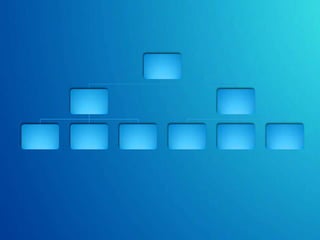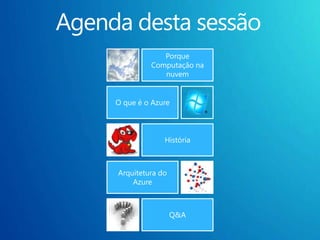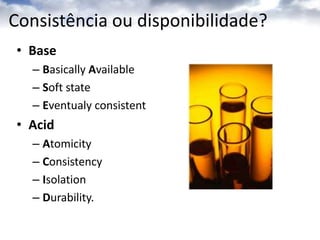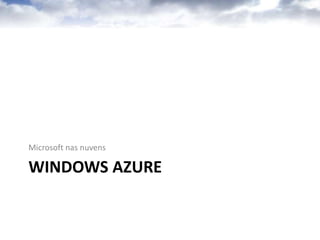Introdução à computação na nuvem e Windows Azure
- 5. 101010101010101001011010 010101010101001011010100101010101010010110101 010101010101001011010 101101010101001011010 01101010101001011010 0101010101001011010 101010101001011010 101010101001011010 01010101001011010tecnoretorica.com.br
- 11. @GiovanniBassi11
- 12. .NET Architect Days 2011http://bit.ly/dnad2011 3 e 4 de Junho de 2011FocoemarquiteturaAcessível: hotel no centro de São PauloInscriçõesabertas!
- 16. Porque computação na nuvemCenário
- 17. Quinta geração da computação
- 18. Cenário inicialAmbiente inicial focado em atender usuários internosProfissionais capacitadosInfra-estruturaDesenvolvimentoVirtualização
- 19. Cenário começa a mudarPassamos a atender clientes externosDemanda bem maiorMaior interatividadeAltas expectativas por parte dos usuáriosDemandas em fins de semana, feriados, não para nunca
- 20. Adequando...Maior quantidade profissionaisMaior escalabilidadeMaior resistência a falhasNECESSIDADES NOVAS
- 21. O que temos feito...Implantamos outro(s) datacenter(s)Aumento da complexidadeQuantos? Dois são o suficiente?Um por localidade / continente?E a latência?E os dados?E a segurança?E a gestão deste ambiente?Custo mais alto
- 22. Impactos na gestãoSistemas para atender esse cenários são diferentes?SimExpertises diferentesprofissionais diferentesSuporte diferenteCustos maiores
- 23. O que é a nuvem?Uma abordagemparacomputaçãoonde o foco é a escala da internet e conectarumavariedade de dispositivos e endpoints
- 24. Capacidade alocadaForecast de cargaFalta de potênciaSobra de potênciaCapacidade de TICarga realTempo
- 25. Forecast de cargaSem clientes reclamandoCapacidade sob demandaCapacidade de TISem capital paradoAumenta ou diminui o poder de computaçãoCapex menorCarga atualTempo
- 26. Padrões de computaçãonanuvem“Crescimentorápido“ “Liga-desliga“ InactivityPeriod Compute Compute Average UsageUsageAverageTime Time Trabalhos batchCapacidadesobreprovisionada é perdidaTempo atéchegaraomercadopodeficarcomplicadoServiçosbemsucedidosprecisamescalarAcompanhar o crescimento é um desafioDifícilprovisionar hardware a tempo“Picosimprevisíveis“ “Picosprevisíveis“ Compute Compute Average Usage Average Usage Time Time Picos em demandanãoesperadosouplanejadosSubidainesperadaimpactadesempenhoDifícilprovisionar em casosextremosServiços com microsazonalidadesTem picosdevido a aumentoperiódico de demandaComplexo e com sobra de capacidade
- 28. Serviçosda nuvemInfrastructure(as a Service)Platform(as a Service)Packaged SoftwareSoftware(as a Service)ApplicationsApplicationsApplicationsApplicationsYou manageDataDataDataDataYou manageRuntimeRuntimeRuntimeRuntimeManaged by vendorMiddlewareMiddlewareMiddlewareMiddlewareManaged by vendorYou manageO/SO/SO/SO/SVirtualizationVirtualizationVirtualizationVirtualizationManaged by vendorServersServersServersServersStorageStorageStorageStorageNetworkingNetworkingNetworkingNetworking
- 29. Consistência ou disponibilidade?Dan Pritchett: http://queue.acm.org/detail.cfm?id=1394128Teorema CAP de Eric Brewer (escolha 2 de 3):ConsistencyAvailabilityPartition tolerance
- 30. Consistência ou disponibilidade?BaseBasically AvailableSoft stateEventualy consistentAcidAtomicityConsistencyIsolationDurability.
- 31. CamadasSurge uma nova camada na arquitetura computacional
- 32. 1: Você
- 33. 2: A corporação
- 34. 3: A web
- 35. A terceira camadaFormada de computação, armazenamento, rede e serviçosDesenvolvidos como capacidade infinitaConsumidos como serviço
- 36. Windows azureMicrosoft nas nuvens
- 37. Internamente na Microsoft...Microsoft já estava muito experiente em software como serviçoLive MessengerOffice HelpPassport/Live IdXboxWindows UpdateHotmailMicrosoft.comForunsEtc, etc, etc...
- 38. Resultado na Microsoft...Ganhou:EscalabilidadePessoalExperiênciaInfra-estruturaSoftware de gestão
- 39. Mas...Não estava preparado para um cliente usar, era muito customizadoCaro demais para vender
- 40. Plano de açãoJá fazemos isso bem, vamos empacotar e vender!
- 41. Para isso foi criado...
- 42. Windows Azure: Microsoft nas nuvensNova plataforma do WindowsWindows 7, Windows Phone 7, Windows ServerFundação para computação na nuvemWindows nas nuvens
- 43. Funcionalidades básicasComputação virtualizadaArmazenamento escalávelSistema de gerenciamento automático (fabriccontroller)Ambiente de desenvolvimento integrado e emulado
- 44. Lembrando que...Não é software que você roda no ambiente da sua empresaVocê não instala o AzureDisponível em praticamente no mundo todoReleases constantes
- 45. Infra-estruturaHaverão dezenas de datacenters ao redor do mundo, já temos 6US$ 500 milhões cada um
- 46. Windows Azure Platform Data CentersNorth America Region Europe Region Asia Pacific Region N. Europe N. Central – U.S. W. Europe S. Central – U.S. E. AsiaS.E. Asia6 datacenters em 3 continentes
- 47. ServidoresTotalmente virtualizadosMáquinas Dell customizadasMáquinas “pequenas” e simplesEm cada máquina virtual:OS: 64-bit Windows Server 2008 CPU: 1.5-1.7 Ghz x64 equivalent Memória: 1.7GB Rede: 100Mbs Disco local: 250GBWindows Azure Storage: 50GB
- 48. Datacenter Azure
- 49. Microsoft runs AzureA própria Microsoft vai começar a colocar suas aplicações SaaS e S+S no AzureWindows LiveOffice LiveExchange OnlineSharepoint OnlineDynamics CRM Online
- 50. Como surgiu o azureHistória
- 51. HistóriaEm desenvolvimento a alguns anosProjeto “RedDog”Nem os VPs sabiam direito o que o time faziaLiberdade total
- 52. TimeOs melhores da casa(bestandbrightest)AmitabhSrivastava (Corporate Vice President)Dave Cutler (Technical Fellow - pai do NT e do VMS)Brad Calder (Director – especialistaemarmazenamento)YousefKhalidi (Distinguished Engineer, antigo Sun utility computing expert)Hoi Vo (especialista de SO e ferramentas de desenvolvimento)G.S. Rana (engenheiro);Hunter Hudson (Expert de provisionamento de datacenters)Manuvir Das (Developer evangelist)A maioria com mais de 10 anos de casa
- 53. Como foi feito“Não vamos copiar o Google ou a Amazon”A idéia era criar um sistema operacional, uma abstraçãoFoco em serviçosFoco em facilidade de gestão
- 54. Do que é feito o azureArquitetura
- 55. Plataforma Windows AzureScalable compute and storageAutomated service managementFamiliar tools, technologies, languages Relational storage for the cloudConsistent development modelAutomated database managementConnect existing apps to the cloudConnect through network boundariesEasily control authorization to apps
- 56. Sistema operacional para a nuvemProcessador, memória, discoServidores, virtualizaçãoRede, tráfegoMúltiplos datacentersComunicaçãoDados, backup
- 57. Sistema de gerenciamento automatizadoAtualização da aplicaçãoAtualização do sistema operacionalSubstituição de máquinas que falhamAbstração do servidor
- 58. Modelagem dos serviços, não dos servidoresGrupos e papéisCanais e endpointsInterfacesConfigurações
- 59. Alta disponibilidadeFalhas em servidores não derrubam um serviçoDados são replicados pelo menos 3 vezesSem intervenção do usuárioSem intervenção da própria Microsoft
- 60. Ambiente de desenvolvimento emuladoAmbiente de desenvolvimento totalmente familiarAinda assim, novoDiferente de um servidor comum
- 61. Experiência rica de desenvolvimentoDesenvolva localmenteTeste localmenteUtilize:Visual Studio 2010ASP.NETC#/VBC++JavaPHPRubyPython
- 62. Plataforma abertaRESTXMLCódigo Nativo e gerenciadoOutros...
- 65. Windows Azure PlatformCachingService BusAccess ControlReportingData SyncDatabaseConnectComputeStorageManagement
- 66. Windows Azure Web & Worker RolesWindows Server 2008 R2 x64.NET Framework – 3.5 SP1 e 4.0CódigoNativo, PHP, Ruby, Python, Java, etc. – tragaseu runtimeFull trustAcesso remoto na consoleAzure Fabric gerencia o ciclo de vida do roleWorker RoleWeb RoleRole incluiIISHTTP/HTTPSASP.NETFast CGI + PHP, Ruby, Java, Python, etcTambém é um worker roleRole é um executávelCrieseu webserver, rode um banco de dados, etc.Inbound onQualquerporta TCPHTTP/HTTPS
- 67. VM RoleVM RoleWeb/Worker RoleControleAbstração
- 68. Portal do Windows Azure
- 69. Preços da plataforma Windows AzurePagueconformeusa, e creçaapenasondevocêprecisaElastic, scalable, secure, and highly available automated service platformHighly available, scalable, and self managed distributed database serviceComputeStorage Web EditionBusiness Edition $9.99/month(up to 1 GB DB/month) Starting at $99.99/month(10-50 GB DB/month)Per GB stored and transactionsPer service hourPer database/month Per database/month $0.05-0.96/hour+ Variable Instance Sizes $0.15 GB/month$0.01/10k transactions Windows Azure AppFabric Service Bus and Access Control ServiceScalable, automated, highly available services for secure connectivityAccess ControlService Bus$3.99/month per connection$1.99/10k transactionsPer Message OperationPer Message OperationPrices shown in USD onlyInternational prices are available
- 70. Links úteisSite do Azurehttp://www.microsoft.com/azureSite do portalhttp://windows.azure.com
- 71. Q&A
Notas do Editor
- #24: Slide Objectives:Explain how Microsoft thinks of the cloudSpeaking Points:There are numerous terms and definitions floating around in the industry for “the cloud”, “cloud computing”, “cloud services”, etc.Microsoft thinks of the cloud as simply an approach to computing that enables applications to be delivered at scale for a variety of workloads and client devices.The cloud can help deliver IT as a standardized service…freeing you up to focus on your business
- #25: Slide Objectives:Understand the challenges of irregular load in applicationsUnderstand the challenges of both too much capacity and not enough capacity and the sort of groups they impact within a customerUnderstand that traditionally IT capacity is purchased in a stepwise fashion involving capital expenditure at each pointSpeaking Points:To understand the value and opportunity for cloud computing, I believe it’s important to think about how IT capacity is typically used by applications today in most environments.Today most organizations significantly over estimate or underestimate the amount of resources they need to run their applications.This leads to a higher cost for the infrastructure and the delivery of the overall applications. Build Steps:Forecast load is to grow steadilyPlanned capacity grows in a stepwise fashion. Need to plan in advance due to hardware lead timesActual load is highly variable over timePeriods where we have excess capacity. Capital laying idle, opex wasted powering and cooling serversPeriods where we have insufficient capacity and our customers get a bad experience
- #28: Slide Objectives:Explain the three established terms in the industry for cloud servicesSpeaking Points:With this in mind, it’s important to understand how to talk about our Cloud Services offerings.There is a lot of confusion in the industry when it comes to the cloud. It’s important that you understand both what is happening in the industry and how we think about the cloud. This is the most commonly used taxonomy for differentiating between types of cloud services.The industry has defined three categories of services:IaaS – a set of infrastructure level capabilities such as an operating system, network connectivity, etc. that are delivered as pay for use services and can be used to host applications. PaaS – higher level sets of functionality that are delivered as consumable services for developers who are building applications. PaaS is about abstracting developers from the underlying infrastructure to enable applications to quickly be composed. SaaS – applications that are delivered using a service delivery model where organizations can simply consume and use the application. Typically an organization would pay for the use of the application or the application could be monetized through ad revenue. It is important to note that these 3 types of services may exist independently of one another or combined with one another. SaaS offerings needn’t be developed upon PaaS offerings although solutions built on PaaS offerings are often delivered as SaaS. PaaS offerings also needn’t expose IaaS and there’s more to PaaS than just running platforms on IaaS.
- #29: Slide Objectives:Explain the differences and relationship between IaaS, PaaS, and SaaS in more detail.Speaking Points:Here’s another way to look at the cloud services taxonomy and how this taxonomy maps to the components in an IT infrastructure. Packaged SoftwareWith packaged software a customer would be responsible for managing the entire stack – ranging from the network connectivity to the applications. IaaSWith Infrastructure as a Service, the lower levels of the stack are managed by a vendor. Some of these components can be provided by traditional hosters – in fact most of them have moved to having a virtualized offering. Very few actually provide an OSThe customer is still responsible for managing the OS through the Applications. For the developer, an obvious benefit with IaaS is that it frees the developer from many concerns when provisioning physical or virtual machines. This was one of the earliest and primary use cases for Amazon Web Services Elastic Cloud Compute (EC2). Developers were able to readily provision virtual machines (AMIs) on EC2, develop and test solutions and, often, run the results ‘in production’. The only requirement was a credit card to pay for the services.PaaSWith Platform as a Service, everything from the network connectivity through the runtime is provided and managed by the platform vendor. The Windows Azure Platform best fits in this category today. In fact because we don’t provide access to the underlying virtualization or operating system today, we’re often referred to as not providing IaaS.PaaS offerings further reduce the developer burden by additionally supporting the platform runtime and related application services. With PaaS, the developer can, almost immediately, begin creating the business logic for an application. Potentially, the increases in productivity are considerable and, because the hardware and operational aspects of the cloud platform are also managed by the cloud platform provider, applications can quickly be taken from an idea to reality very quickly.SaaSFinally, with SaaS, a vendor provides the application and abstracts you from all of the underlying components.
- #47: Slide ObjectiveUnderstand that Microsoft has a long history in running data centres and online applications. Bing, Live, Hotmail etc….Understand the huge amount of innovation going on at the data center levelSpeaking Points:Microsoft is one of the largest operators of datacenters in the worldYears of ExperienceLarge scale trustworthy environmentsDriving for cost and environmental efficientlyWindows Azure runs in 3 regions and 6 datacenters todayData center innovation is driving improved reliability and efficiencyPUE = Power Usage Effectiveness = Total Facility power/IT Systems Power = Indication of efficiency of DCUnder 1.8 is very good, modern cloud DCs approaching 1.2Multi-billion dollar datacenter investment700,000+ square foot Chicago and the 300,000+ square foot Dublin, Ireland data centersMicrosoft cloud services provide the reliability and security you expect for your business: 99.9% uptime SLA, 24/7 support. Microsoft understands the needs of businesses with respect to security, data privacy, compliance and risk management, and identity and access control. Microsoft datacenters are ISO 27001:2005 accredited, with SAS 70 Type I and Type II attestations.Notes:http://www.globalfoundationservices.com/http://blogs.msdn.com/the_power_of_software/archive/2008/06/20/microsoft-s-pue-experience-years-of-experience-reams-of-data.aspxhttp://blogs.msdn.com/the_power_of_software/archive/2008/06/27/part-2-why-is-energy-efficiency-important.aspx
- #66: Speaking Points:At PDC10 in just over a month, we will introduce several new services including: Caching and Reporting. We will also have a new CTP for the Data Sync Service and Project Dallas will be finally available. Let’s drill into these services in a bit more detail.--Speaking Points:I suspect most if not all of you in this room are familiar with the Windows Azure Platform today.Today the platform consists of a set of foundational services SQL Azure relational databaseAppFabric provides services that can be used by any apps – hosted in Windows Azure, on-premises, or hosted in another environment. Questions:How many of you are building applications for Windows Azure?How many are using SQL Azure?How many are using the Access Control service today? The Service Bus?Notes:Windows Azure StoryWe are building an open platform to run your applications in the cloud. Your apps are .NET, Java, PHP, etc. We love everyone.We are going to help you migrate your existing apps to the cloud. The cloud platform is the future. Enables scale, self-service, lowers friction, etc. We provide the best cloud platform for building new apps. (aka n-tier, web services, etc.)
- #67: Slide Objectives:Understand Roles in generalUnderstand Web and Worker Roles at a high levelSpeaking Points:Windows Azure currently supports the following two types of roles:Web role: A web role is a role that is customized for web application programming as supported by IIS 7 and ASP.NET.Worker role: A worker role is a role that is useful for generalized development, and may perform background processing for a web role. A service must include at least one role of either type, but may consist of any number of web roles or worker roles. A worker role is started by a call to a well know managed code interface RoleEntryPoint. A worker role must extend this class and override the Start() methodA web role is a worker role with the addition of IIS being installed. i.e. it has all the features of and can do everything a worker role can do as wellNotes:http://msdn.microsoft.com/en-us/library/dd179341.aspx#Subheading1
- #69: Speaking Points:
- #70: Slide Objectives:Provide overview and detail on pricingDiscuss localization of pricingSpeaking Points:Windows Azure is charged per compute hour.Pricing is localized for global marketsDifferent VM sizes have a different number of CPUs and therefore are a multiple the single CPU rateCompute time, measured in service hours: Windows Azure compute hours are charged only for when your application is deployed.remove the compute instances that are not being used to minimize compute hour billing. Partial compute hours are billed as full hours.Storage, measured in GB: Storage is metered in units of average daily amount of data stored (in GB) over a monthly period. Data transfers measured in GB (transmissions to and from the Windows Azure datacenter).Data transfers within a sub region are free. Transactions, measured as application requests to the REST serviceSQL Azure is priced on a per database per month basisAppFabric Service Bus is based on a per connection modelAppFabric Access control is based on a per transaction modelAppFabric Service Bus connections can be provisioned individually on a “pay-as-you-go” basis or in a pack of 5, 25, 100 or 500 connections. For individually provisioned connections, you will be charged based on the maximum number of connections you use for each day. For connection packs, you will be charged daily for a pro rata amount of the connections in that pack (i.e., the number of connections in the pack divided by the number of days in the month). You can only update the connections you provision as a pack once every seven days. You can modify the number of connections you provision individually at any time.For AppFabric Access Control transactions, customers will be charged the actual number of transactions utilized for the billing period (i.e., not in discrete blocks of 100,000 transactions), plus data transfers in or out.Notes:http://www.microsoft.com/windowsazure/pricing/http://blogs.msdn.com/b/netservices/archive/2010/01/04/announcing-windows-azure-platform-commercial-offer-availability-and-updated-appfabric-pricing.aspx http://www.microsoft.com/windowsazure/pricing/






































































